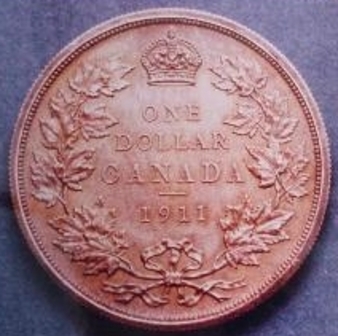Considered the greatest, and most storied, rarity in all of Canadian numismatics, and one of only two examples struck in silver. The other coin is permanently housed in the National Currency Collection in Ottawa along with a single striking in lead.
If the 1921 Half Dollar is the "King of Canadian Coins," then what else is this fabulous piece but, "The Emperor of Canadian Numismatics." The Dominion of Canada Currency Act of 1910 provided for the striking of a Canadian Silver Dollar in .925 silver with a weight of 360 grains. A coinage press was obtained from England for the purpose of striking Dollar-size coins. The Royal Mint prepared dies and a pair of Specimens were struck in silver, and one in lead. The cases for the Specimen sets of the first Canadian coinage of George V contained a slot specifically for a Dollar coin. For some reason, Canadian government authorities decided against issuing business strike Silver Dollars at this time. Sir E. Bertram MacKennal designed an obverse that displays George V, in crown and robes, facing left. The initials B.M. appear on the truncation of the bust. The legend is in Latin and translates as GEORGE V, BY THE GRACE OF GOD KING AND EMPEROR OF INDIA. The reverse was designed by W.J. Blakemore and taken from a previous design by the noted British coin and medal designer, Leonard C. Wyon. The reverse design has a crown at 12 o'clock, above a maple wreath which surrounds the legend ONE-DOLLAR-CANADA-1911. Another interesting fact about this special coin is that no other first-year George V coin has DEI GRA (for Dei Gratia, or By the Grace of God) in the legend.
All of the other 1911 coinage is referred to as "Godless" because of the omission. This issue can best be described as a pattern, as it was a proposed coin with no business strikes ever produced. The two known Pattern Dollars, as well as the lead striking, were struck in London before the dies were sent to Canada. Major Sheldom S. Carroll, Chief Curator of the National Collection at the Bank of Canada stated, "When consideration was being given to issuing a Dollar coin in 1911, dies were prepared (in London) and trial strikes were made. Mint records do not tell us how many such strikes were produced. Until November 19, 1977 the only two known trial strikes were in silver. The lead striking was discovered shortly thereafter on November 20, 1977. It was sent to the Department of Finance in Ottawa for examination and had remained there in a brown paper parcel in the East Block of the Parliament Buildings for more than 65 years. No examples of the 1911 Dollar were known until 1960 when the noted London coin dealer B.A. Seaby obtained this coin from "an undisclosed source," but word quickly spread that the coin had been purchased from the family of Sir Willian Grey Ellison-MacCartney who was the Mint Master at the time the coins were struck. Seaby later discovered the second silver example at the Royal Mint Museum in London. That is the coin that is on permanent loan to the National Currency Collection in Ottawa.
This is the only collectible example of the 1911 silver Dollar--The classic Canadian rarity and the most publicized Canadian coin of all times (once listed in the Guiness Book of World Rarities as the world's most valuable coin). Even though it may no longer be the world's most valuable coin, it is definitely Canada's most valuable numismatic item and it is much rarer than vastly more expensive coins such as America's 1804 Dollars and 1913 Liberty Nickels. Graded SPECIMEN 65 by PCGS, this piece is deeply toned in shades of gold, purple, red, and brown with a flawless strike. Those who have viewed both this coin and the example in the National Currency Collection consider this piece, the Belzberg 1911 Dollar, to be the finer of the two silver specimens.

 Visit us on Facebook
Visit us on Facebook
 Follow us on Twitter
Follow us on Twitter